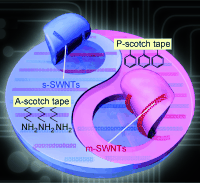I like the use of simple, homely tools in science and the use of sticky tape (or scotch tape) to isolate graphene by Andre Geim and Konstantin Novoselov for work that led to a Nobel prize certainly fits that category.
Scientists inspired by the ‘sticky tape technique’ for separating graphene from graphite (you can view a video which shows you how to do this at home using a lead pencil in my November 26, 2010 posting) have devised a nondamaging means of separating metallic and semiconducting single-walled carbon nanotubes. From the abstract for the paper, Separation of Metallic and Semiconducting Single-Walled Carbon Nanotube Arrays by “Scotch Tape” (the paper is behind a paywall),

Amine-functionalized A-scotch tape selectively removes s(semiconducting)-SWNTs, the phenyl-functionalized P-scotch tape acts specifically towards m (metallic)-SWNTs.
From the Sept. 12, 2011 news item on Nanowerk,
The researchers used thin films of polydimethylsiloxane (PDMS) chemically modified with either amino or phenyl groups as a type of scotch tape to lift CNTs from the sapphire substrate on which they were prepared (see image). The amino-type scotch tape selectively removes semiconducting CNTs from a mixture of CNTs on the substrate surface, whereas the phenyl-type scotch tape selectively removes only metallic CNTs, without disturbing the CNTs left behind. “Compared with current separation methods based on selective adsorption, we have successfully extended the mechanism to a long nanotube system and controlled the formation of carbon nanotubes perfectly,” says Zhang [Jin Zhang].
If they can find a way to make this technique more productive (only a small number of carbon nanotubes can be separated at this time), then there is great potential for their use in solar cells and other such devices.